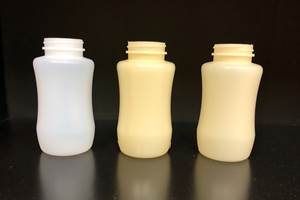Close-Up On Technology - Melt-Phase Billet Forming Adds New Option for Containers
PBM Plastics in Newport News, Va., has commercialized a variant of the thermoforming process that reportedly produces deep-draw, highly uniform containers with low internal stresses.
PBM Plastics in Newport News, Va., has commercialized a variant of the thermoforming process that reportedly produces deep-draw, highly uniform containers with low internal stresses. PBM’s melt-phase billet forming process can produce flexible and rigid containers for packaging liquid and dry foods as well as viscous industrial liquids.
“Our hybrid process combines thermoforming and blow molding,” says Adam Burke, PBM’s president. The process punches donut-shaped billets from sheet, heats them precisely to the melting point, then forces the material with air pressure into mold cavities. It reportedly can make very thin, collapsible liners or rigid cans capable of withstanding 280 F retort conditions.
PBM’s initial commercial products are a 2-mil-thick, collapsible HDPE baby-bottle liner for parent company PBM Products, and a breast-pump liner able to resist cold impacts. Other billet-formed products expected in coming months include a flexible liner for dispensing paint and a rigid container using EVOH as an oxygen barrier to replace steel cans for vegetables, soup, and seafood.
How the process works
PBM’s process integrates concepts not previously combined into a production-ready system. It starts with billets of predetermined diameter and thickness. They are punched from sheet in staggered patterns that reduce the web scrap to 17% vs. the 40% scrap rate typical for roll-fed sheet forming. The process bears some similarities to a “scrapless” forming method developed decades ago by Dow Plastics, in which barrier sheet is punched into squares that are impact-formed and then drawn into molds.
Billet forming is performed exactly at the melting point, requiring precise heat control. In that regard it is somewhat similar to solid-phase pressure forming (SPPF) developed by Shell Chemical, in which PP or HPDE sheet is formed in a narrow temperature range just below the melting point. (PBM acquired the SPPF patents several years ago).
“Our achievement is a system offering high throughput and quality,” claims Burke. Billets are transferred robotically to the oven and forming stations, then forced into aluminum molds using plug assist and air pressure. PBM makes its own proprietary equipment and molds. Burke says the process easily produces containers with up to 6:1 draw ratio, and a 10:1 ratio is feasible. The relatively low web-trim fraction allows 100% reclaim in a closed loop with sheet extrusion.
Expanding opportunities
The process can make ultra-thin, flexible, and seamless liners of 1 to 8 mils (0.001 to 0.008 in.)—thin enough to collapse as contents are removed. A rigid flange around the neck opening of the liners facilitates sealing.
PBM plans to take collapsible liners into hard-to-dispense industrial liquids like paints, sealants, stains, and adhesives. Collapsible liners offer full evacuation of contents and easy disposability. A cartridge liner for a paint gun was set to debut last month. PBM is also investigating use of liners in bio-containers for medical-waste collection and disposal bags.
Melt-phase billet forming also extends the boundaries of retort packaging. PBM containers survive retorting at up to 280 F vs. 200 to 220 F for most plastic containers. Low residual stresses and outstanding interlayer adhesion are credited for this performance. PBM containers could replace metal cans in foods requiring extreme retorting. For example, PBM has prototyped a heat-sealable retort can for processed fish; a clear cup for vegetables, soups, and seafood; and a coffee canister.
PBM is investigating the use of nylon, biodegradable polyester, and ionomer resins to make billet-formed containers. Super-glossy ionomer alloys from DuPont have been formed into cosmetics containers that combine high gloss with scratch and mar resistance. They avoid the cost of painting or coating. PBM has also helped develop a method for incorporating lenticular and holographic labels into billet-formed containers.
To meet fast-growing market demand, PBM will double billet-forming capacity at its Newport News plant in the next few months. PBM will also consider licensing the process for specific non-competing uses.
Related Content
PolyJohn Turns to Blow Molding, Doubles Its Productivity
Leading maker of portable sanitation products knew thermoforming, sheet extrusion, rotomolding and injection molding. Then it found the missing link to higher productivity and new markets: blow molding.
Read MoreFor Extrusion and Injection-Blow Molders, Numerous Upgrades in Machines and Services
Uniloy is revising its machinery lines across the board and strengthening after-sales services in tooling maintenance, spare parts and tech service.
Read MoreBreaking News From NPE2024
Here is a firsthand report of news in injection molding, extrusion, blow molding and recycling not previously covered.
Read MoreHow to Extrusion Blow Mold PHA/PLA Blends
You need to pay attention to the inherent characteristics of biopolymers PHA/PLA materials when setting process parameters to realize better and more consistent outcomes.
Read MoreRead Next
People 4.0 – How to Get Buy-In from Your Staff for Industry 4.0 Systems
Implementing a production monitoring system as the foundation of a ‘smart factory’ is about integrating people with new technology as much as it is about integrating machines and computers. Here are tips from a company that has gone through the process.
Read MoreBeyond Prototypes: 8 Ways the Plastics Industry Is Using 3D Printing
Plastics processors are finding applications for 3D printing around the plant and across the supply chain. Here are 8 examples to look for at NPE2024.
Read More









